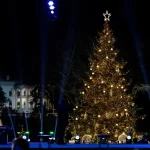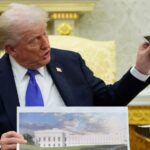

Leaders from Japan and the Philippines will be meeting with President Joe Biden this week, but it’s another country that will be on everyone’s mind.
The president is hosting a state visit with Japan Prime Minister Fumio Kishida and his wife, complete with a state dinner and various diplomatic events. Yet the more serious discussions will likely center on combatting the influence of China.
“The U.S. has been striving for greater regional coordination against the growing Chinese threat, and the leaders will likely agree to joint trilateral naval patrols in the South China Sea,” said Heritage Foundation senior research fellow Bruce Klingner. He added that “security issues will feature prominently during Kishida’s visit.”
Thursday’s schedule of events includes a meeting with not only Kishida but also Philippine president Ferdinand Marcos Jr., which Klingnger said is part of American efforts to create a “latticework” of security partnerships in the region surpassing the former “hub and spoke” system.
Kishida will address a joint session of Congress while in town, urging both political parties to work together in the Indo-Pacific. “Coping with China motivates much of the agenda,” wrote Council on Foreign Relations expert Sheila A. Smith.
Biden and Kishida will work on ways to upgrade military cooperation in case of a crisis, and Smith predicted Kishida could also push for action against Russia due both to that country’s geographic reach into Asia and the parallels with China’s aggression toward Taiwan.
Japan has been a leading provider of economic assistance and support for Ukraine and has issued sanctions on Russia. On the home front, Japan has announced plans to increase its military spending by up to 2% of its gross domestic product.
Senior administration officials previewed the visit on a conference call with reporters, saying the visit is a test of Biden’s strategy within the region.
“The Japan experience and what we’ve seen with Prime Minister Kishida is a case study in recognizing that the best possible way forward is a deep, substantial, continuing engagement with the United States,” the official said, adding that China has been working to isolate the Philippines, whereas coordination with the United States will leave China as the isolated country.
Dealing with China will not be the only issue on the table. The U.S. presidential election may be on Kishida’s mind, as both Biden and former President Donald Trump have opposed the sale of U.S. Steel to a Japanese company with an eye on Rust Belt voters. Trump has further proposed sweeping new tariffs that could affect Japan and other major U.S. trading partners.
More nuanced, local issues could also be on the agenda, including Japan providing new cherry blossom trees for the Washington National Mall and the possibility of building a high-speed rail link between Houston and Dallas using Japanese bullet train technology.
National security adviser Jake Sullivan was asked about that project during Tuesday’s White House press briefing but avoided the topic, saying he could not confirm whether Biden and Kishida would talk about it.
Sullivan did preview other parts of the visit, saying the pair have met nearly a dozen times and that the visit will “deepen our partnership” on space travel, technology, economic investment, fighting climate change, and coordinating global diplomacy.
Though he did not name China, Sullivan also mentioned military cooperation.
“[Biden and Kishida] will announce measures to enhance our defense and security cooperation, to enable greater coordination and integration of our forces, and to ensure that they are optimally postured and linked to other like-minded partners,” he said.
CLICK HERE TO READ MORE FROM THE WASHINGTON EXAMINER
Sullivan stressed that cooperation with Japan and the Philippines must increase in the face of threats.
“The U.S., Japan, and the Philippines are three closely aligned maritime democracies with increasingly convergent strategic objectives,” he said. “Just this past week, our three countries and Australia held joint naval drills in the South China Sea.”






